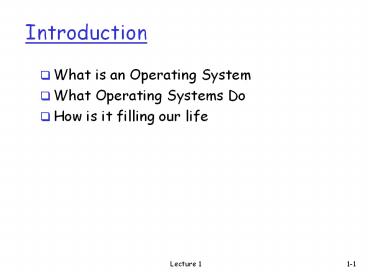What is an Operating System - PowerPoint PPT Presentation
Title:
What is an Operating System
Description:
Title: 4th Edition: Chapter 1 Author: Jim Kurose and Keith Ross Last modified by: ssengupta Created Date: 10/8/1999 7:08:27 PM Document presentation format – PowerPoint PPT presentation
Number of Views:44
Avg rating:3.0/5.0
Title: What is an Operating System
1
Introduction
- What is an Operating System
- What Operating Systems Do
- How is it filling our life
2
What is an Operating System?
- A program that acts as an intermediary between a
user of a computer and the computer hardware - Operating system goals
- Execute user programs and make solving user
problems easier - Use the computer hardware in an efficient manner
- Make the computer system convenient to use
3
What is a Computer System?
- Computer system structure can be divided into
four components - Hardware provides basic computing resources
- CPU, memory, I/O devices
- Application programs define the ways in which
the system resources are used to solve the
computing problems of the users - Word processors, compilers, web browsers,
database systems, video games - Users
- People, machines, other computers
- Operating system the manager of the above
three - Controls and coordinates use of hardware among
various applications and users
4
Computer System and how OS fits into it
5
Operating System Definition
- From system point of view
- OS is a resource allocator
- Manages all resources
- Decides between conflicting requests for
efficient and fair resource use - OS is a control program
- Controls execution of programs to prevent errors
and improper use of the computer
6
How OS evolved
- Mainframe Systems
- One of the earliest computer systems
- Huge computers
- Very simple systems
- Can process one job after another
- Jobs were fed with punch cards
- Operators sort jobs into batches
- Also known as Batch Systems
- Mainframe systems have severe efficiency problem
- WHY?
Image courtesy http//en.wikipedia.org/wiki/File
Ibm704.gif
7
Mainframe OS severe disadvantages
- Mainframe Systems
- Process one job after another
- Jobs were fed with punch cards
- CPU works in microseconds range
- I/O system very slow
- Approx. 1200 cards/min.
- 20 cards/sec.
- CPU is almost always idle!!!
- It was needed to keep multiple jobs ready so that
CPU does not become idlehow? - Introduction of disk technology changed the
complete OS history
Image courtesy http//en.wikipedia.org/wiki/File
Ibm704.gif
8
Multiprogrammed Systems
- Multiprogramming needed for efficiency
- Single user cannot keep CPU and I/O devices busy
at all times - Multiprogramming organizes jobs (code and data)
so CPU always has one to execute - How to achieve this?
- Disk technology helped us to keep multiple jobs
in job pool (Disk) - A subset of total jobs in system is kept in
memory - One job selected and executed
- When it has to wait (I/O for example), OS
switches to another job
- Multiprogrammed introduced two novel challenges
- Job scheduling
- Memory management
9
Time-Sharing Systems
- Time-sharing systems are logical extension of
multiprogrammed systems - Also known as multitasking
- Each user has at least one program executing in
memory ?process - CPU switches jobs so frequently that users can
interact with each job while it is running,
creating interactive computing - Response time should be lt 1 second
- If several jobs ready to run at the same time ?
CPU scheduling - If processes dont fit in memory, swapping moves
them in and out to run - Virtual memory allows execution of processes not
completely in memory
10
Multiprocessor Systems
- Most systems use a single general-purpose
processor (PDAs through mainframes) - Multiprocessor systems growing in use and
importance - Also known as parallel systems, tightly-coupled
systems - Advantages include
- Increased throughput
- Economy of scale
- Increased reliability graceful degradation or
fault tolerance - Two types
- Asymmetric Multiprocessing
- Symmetric Multiprocessing
11
Symmetric Multiprocessing Architecture
12
A Dual-Core Design
13
Shift to Distributed Systems
- Client-Server Computing
- Distributed systems over the network
- Many systems now servers, responding to requests
generated by clients - Compute-server provides an interface to client to
request services (i.e. database) - File-server provides interface for clients to
store and retrieve files
14
Peer-to-Peer Systems
- Another model of distributed system
- P2P does not distinguish clients and servers
- Instead all nodes are considered peers
- May each act as client, server or both
- Node must join P2P network
- Registers its service with central lookup service
on network, or - Broadcast request for service and respond to
requests for service via discovery protocol - Examples include Napster and bitTorrent
15
Change in Computing Environments
- Traditional computing
- Office environment
- Earlier, PCs connected to a network, terminals
attached to mainframe or minicomputers providing
batch and timesharing - Now, portals allowing networked and remote
systems access to same resources - Home networks
- Earlier, used to be single system, then modems
- Now, firewalled, networked

